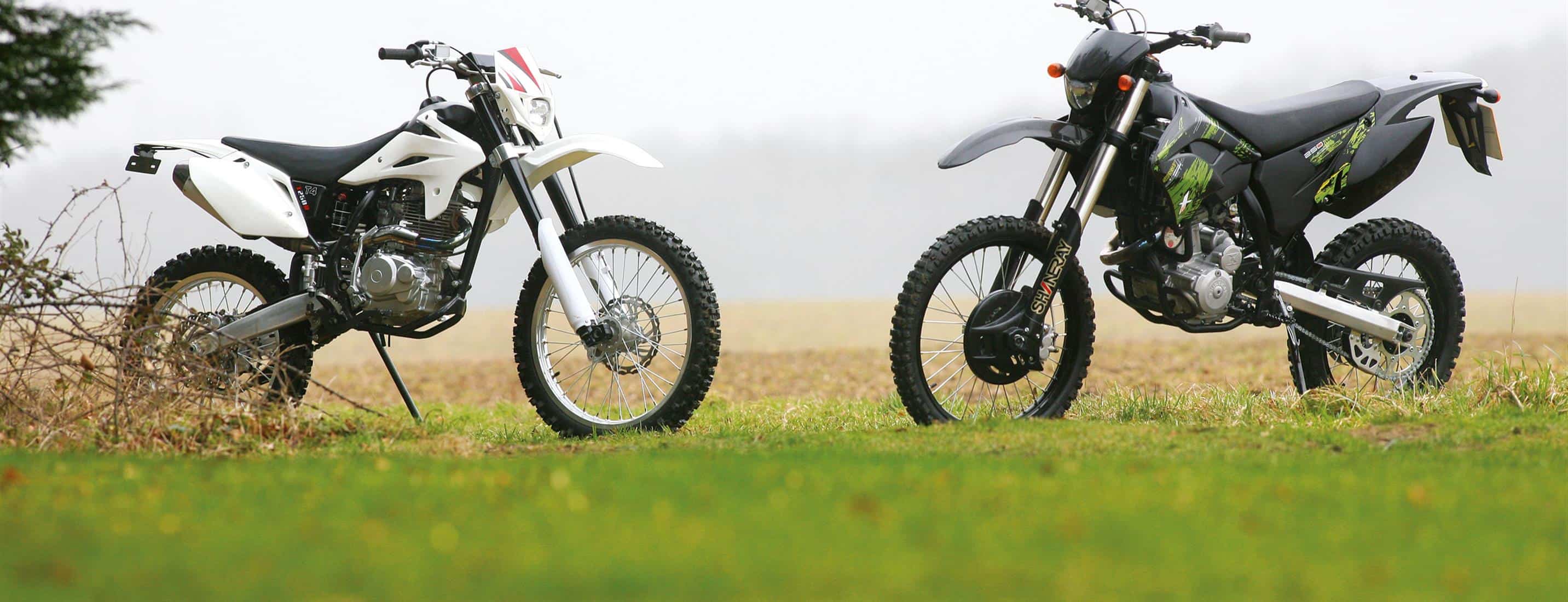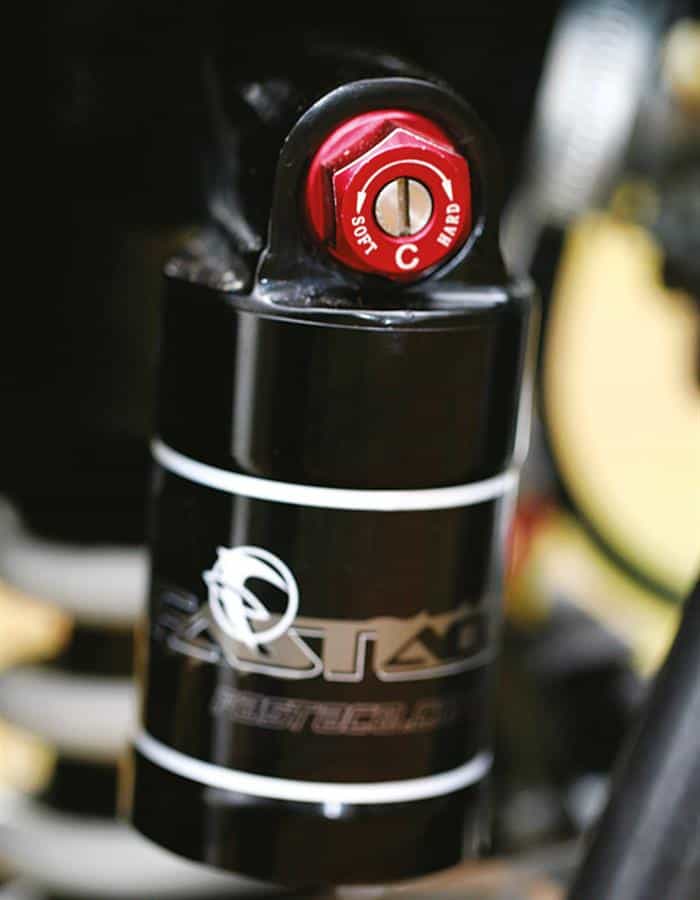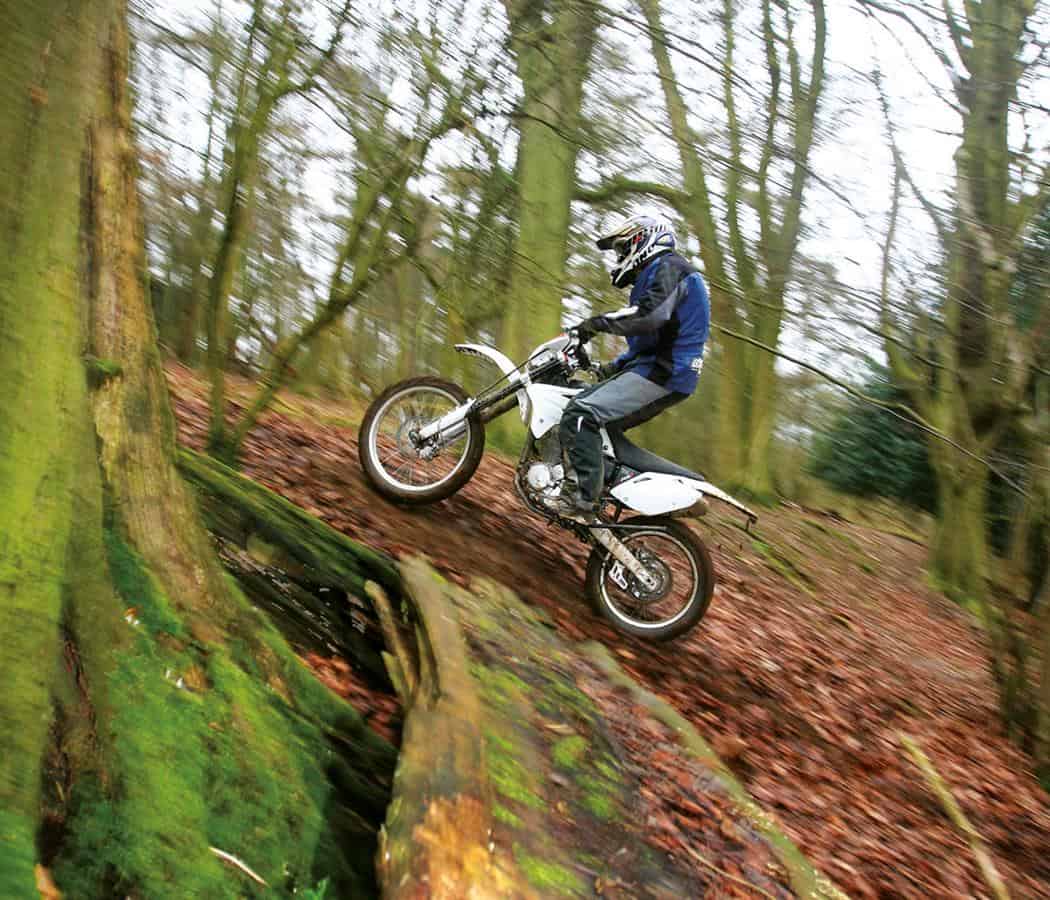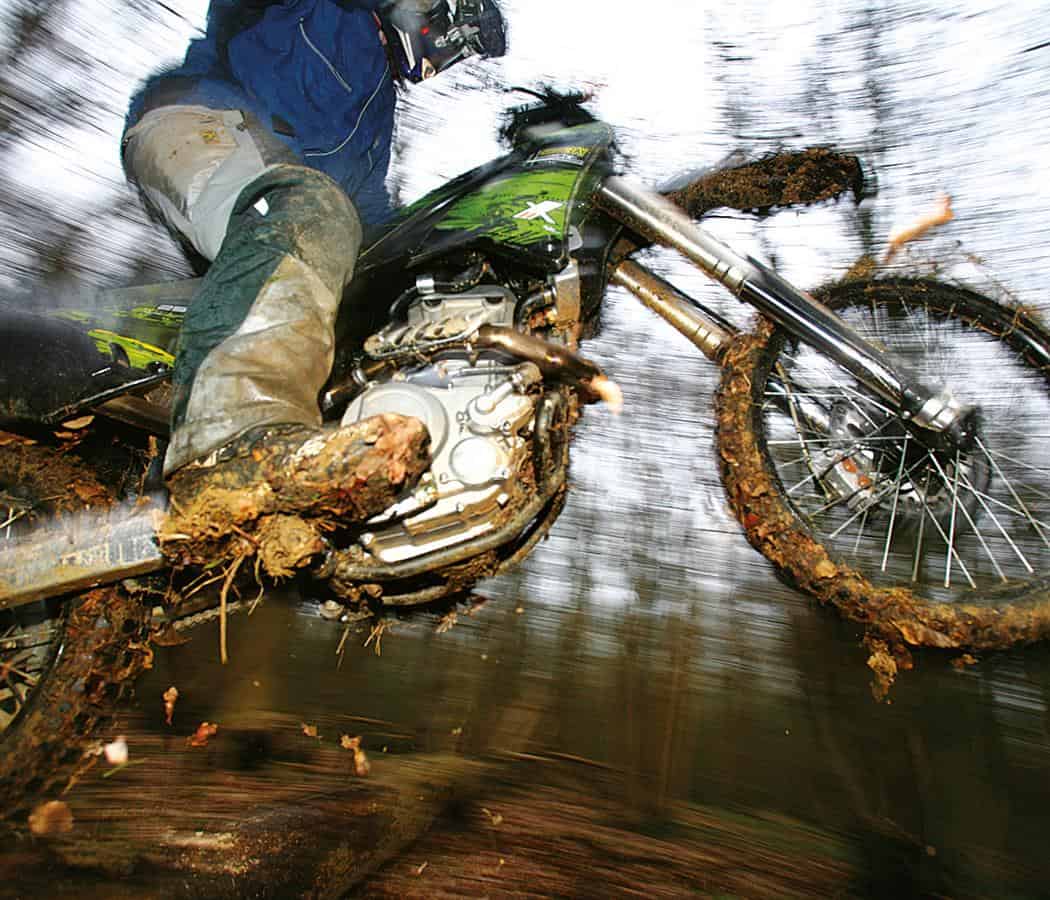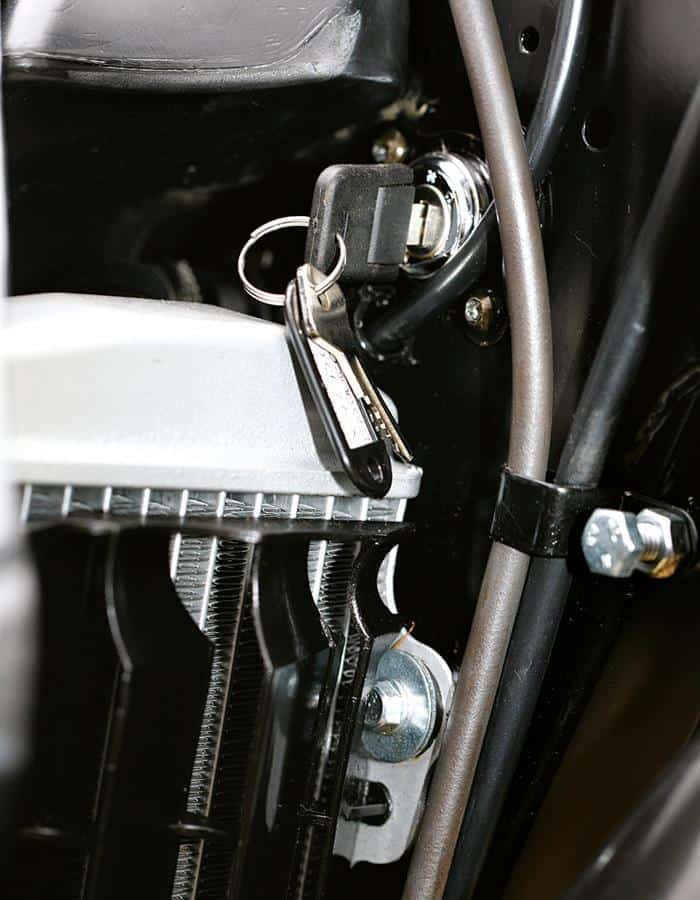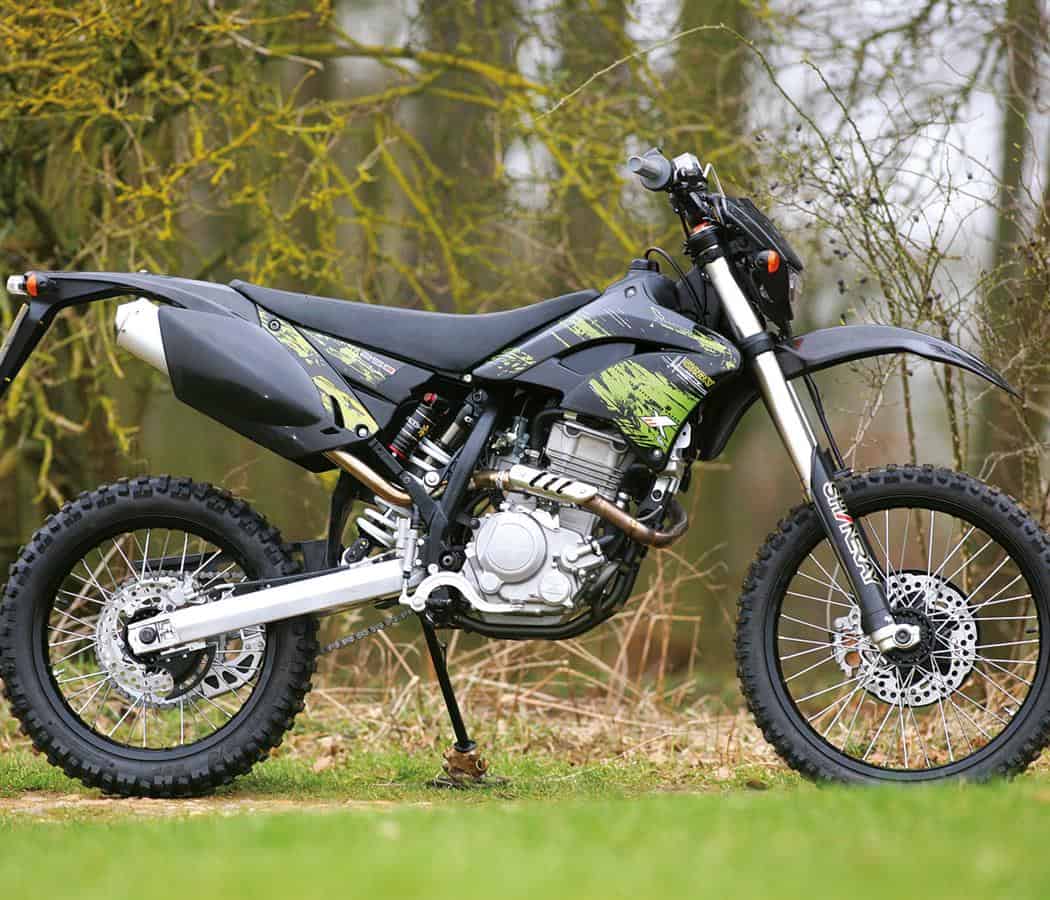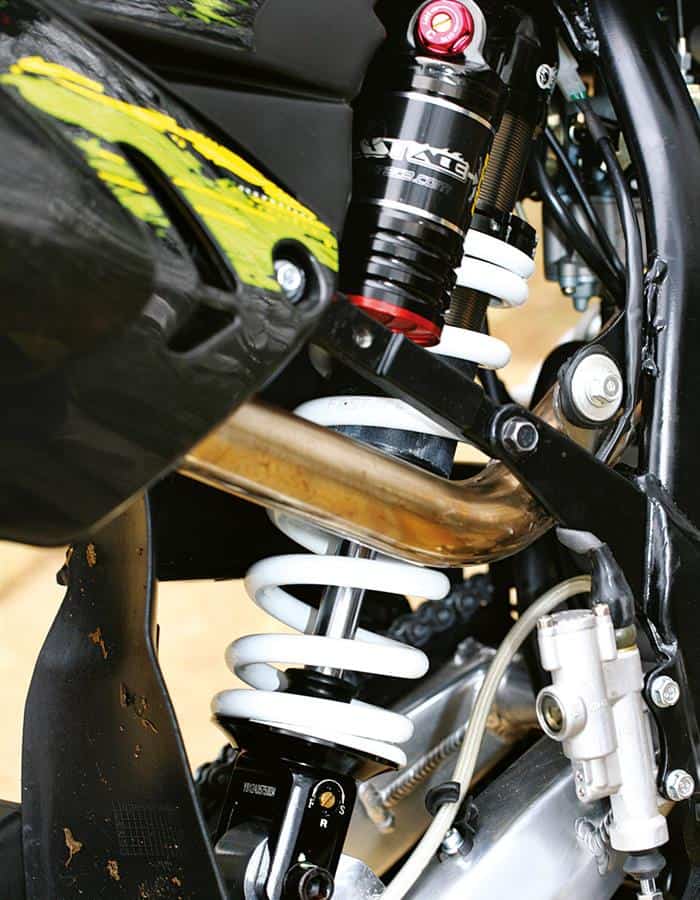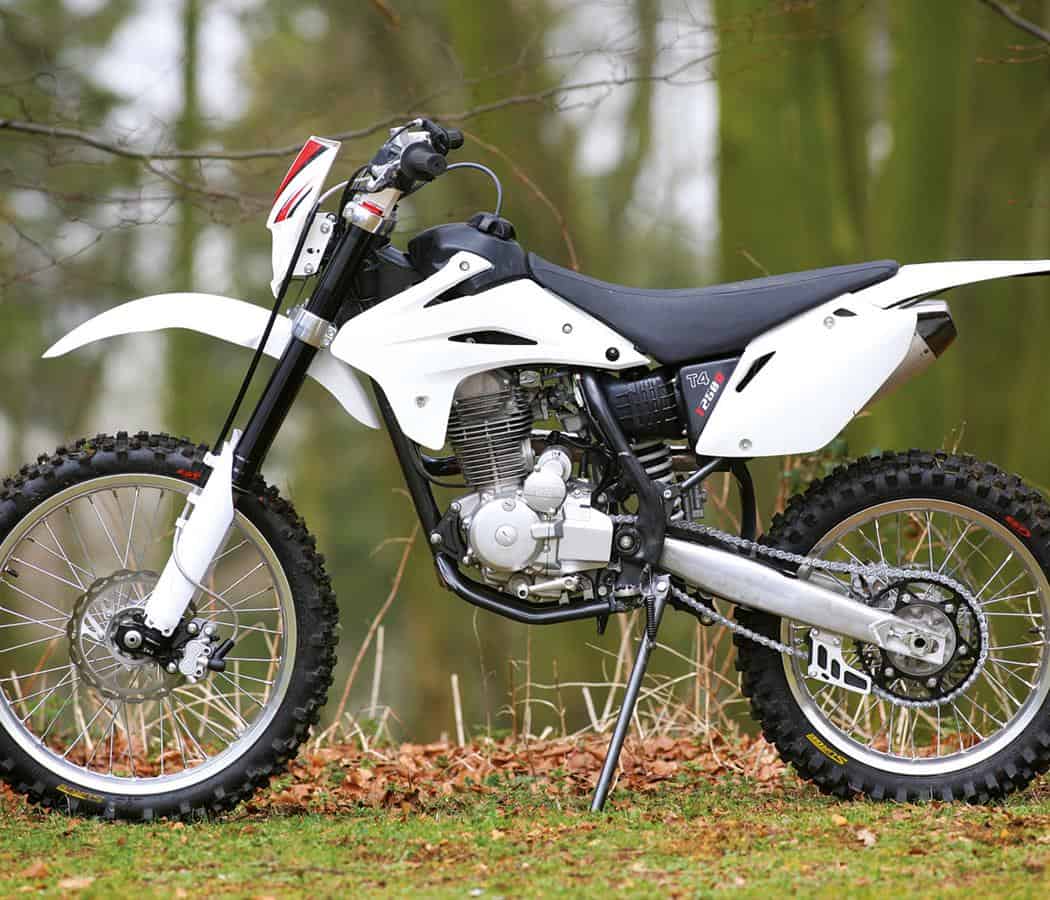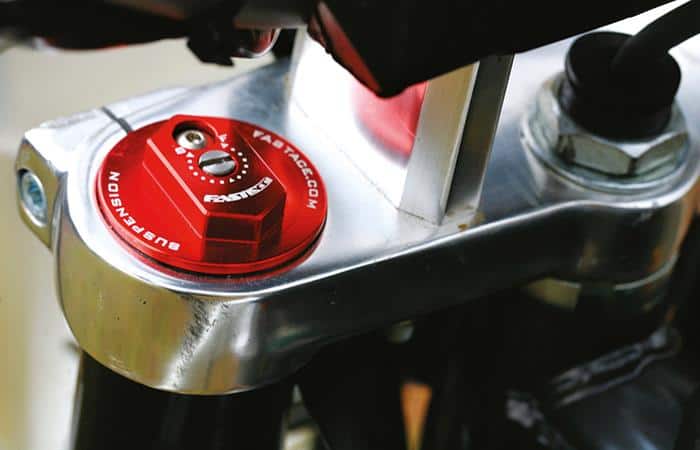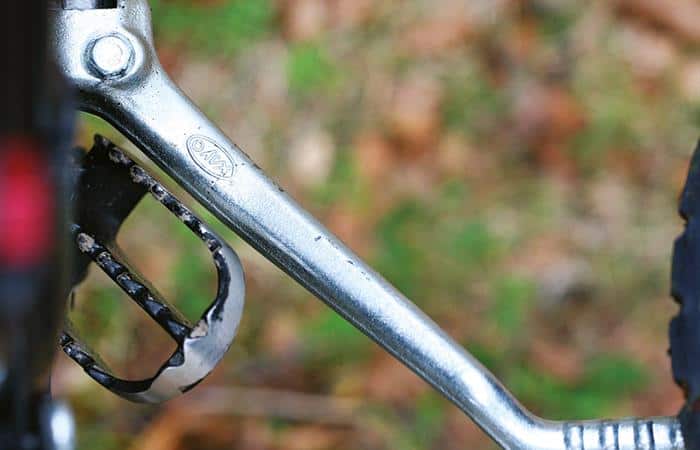Is a decent Chinese dirtbike as rare as a promiscuous panda or can the world’s largest population finally bring us a great green laner? RUST investigates with a two-bike trail test…
China means different things to different people. Ask a Guardian reader about the country and you’ll doubtless hear about their human rights record, whereas mention the country to someone who takes the FT every morning and they’ll tell you how the nation is taking over the economic world. But talk ‘China’ to a dirtbiker and you’ll probably get a full-on belly laugh and snorts of derision. Yep, mention the words ‘Made in China’ i n off-road circles and you expect a response about hideous styling, woeful build quality, sub-standard parts, a complete lack of power, and (the list goes on…) the kind of depreciation which makes investing in Libyan holiday villas seem a sound financial decision. Indeed, here are some of the comments we made the last time we tested a bike from the People’s Republic, back in September 2005: ‘The Chinese welder appears to have learnt his trade by correspondence course though it seems that he flunked out of the painting module’. ‘It’s wrapped in a set of plastics more fragile than the Terracotta army’. ‘It’s one of those bikes which looks awkward from every angle.’
Of course, all of this paints a particularly unattractive picture of Chinese motorcycles, so why would anyone have considered buying one? The price, that’s why! Back then, and pretty much now, you’d expect to pay roughly half the price of an ‘equivalent’ Japanese machine. And when you don’t have much cash to splash, that’s a tempting way to a new set of wheels.
So five years on from our last test of a Chinese-built machine, have their dirtbikes developed as fast as their economy and are we missing out by dismissing them as sub-standard oddities..? Or are they still just cheap to buy, awful to ride, depreciation disasters..?
China White
Dish number one on our Chinese menu is the Stomp T4, not a very Far Eastern sounding name and with good reason: Stomp are based in Hampshire. They’re not just a fly-by-night importer looking to make a quick buck flogging whatever they can cram into a container tho’, they’re established pitbike specialists (yep, there’s a hardcore of riders still into ‘em) and liaise closely with a Chinese factory in order to get the spec of bikes they want.
That said, the T4 is the only ‘full-size’ bike in their range. Actually, with a 1330mm wheelbase it’s still pretty small, so let me rephrase that: it’s the only bike they sell where the seat is higher than your shins.
There’s no doubt that Chinese manufacturers are well versed in copying the look of products, even if they’re not always made to quite the same standards. The country apparently has a thriving industry in fakes – everything from watches to washing powder – and it won’t come as much of a surprise to learn that the T4’s motor heavily resembles Honda’s 230cc SOHC air-chilled motor, as found in the CRF230F. I think it’s fair to say the styling isn’t quite so convincing, or as cohesive, as the popular Honda but it’s still unmistakably a 230F copy – even if the sticker on the side is fibbing about it being a 250.
Unlike the Japanese machine, the Stomp comes equipped with disc brakes at BOTH ends (albeit of unnamed manufacture) and a kickstart as well as the electric button. The fact that using the kickstart lever requires the footpeg to be folded up out of the way is something Stomp have raised with the factory so we’ll overlook that little faux pas and move on.
Suspension comes courtesy of Fast Ace, and no, we hadn’t heard of them either, so we looked ‘em up on the web and found that they’re the brand name of Taiwan Hanbin Machinery Co Ltd/Hecheng Metal Product (Zhongshan) Co Ltd – well, you can’t stamp THAT mouthful on your products – and have been making suspension components since 1996, mainly serving the pitbike market. Externally, the parts look well finished with decent anodising and some neat machining, so we had high hopes of a reasonable ride.
Items such as the very basic switchgear, and headlight bracket cobbled together from a strip of bent metal are less inspiring and will hopefully hit the skip when the bike is released in road legal form later this year. Expect to see black plastics and graphics on these too, in place of the plain white bodywork of our test bike.
Ray Gun
The Shineray (pronounced ‘shin-eray’ rather than ‘shine-ray’) XY250GY-2 might have a less catchy name but it’s a full size, fully road legal trail bike. And it’s not bad looking either.
Sure, the plastics are a little rough around the edges, the sidestand’s waaay too short, some of the welding could be neater, and the wiring for the rear brake light wiring is routed so that it’s (special) fried against the exhaust pipe, but on the whole it’s very well finished. Actually, think about that last sentence for a second because those are all criticisms we could level at certain European manufacturers and not just in the budget trailie market. There are enduro brands who still can’t, or won’t, address such issues!
Engine-wise, Shineray have built their own version of Honda’s liquid-cooled DOHC 250 lump, as found in the XL250 Degree and 250 Dominator. At more than two decades old, it’s not the most advanced engine design, and nor is it one that the UK market will be overly familiar with as many of the bikes which employed it were only ever grey imports. Compared to the current trend for miniaturised four-stroke thumper motors it’s a physically large lump too, and no doubt contributes considerably to the Shineray’s 133kg weight.
Like the T4, the XY250 runs Fast Ace suspension front and rear, albeit they are different units to the white bike’s and the Shineray runs a linkless rear-end whereas the Stomp uses a linkage. It’s also worth noting that (on both bikes) they feature a full range of adjustment both front and rear – pretty rare on a trail bike, especially a budget machine.
From the Shineray’s 950mm-high, and reasonably flat, gripper seat, the dash looks rather neat. The digital speedo has an easy-to-read (if a little small) display and features idiot lights for main beam, indicators, and a neutral light. Best of all are the braceless bars and the KTM-esque two-position adjustable bar clamps, which allow for some fine-tuning of the riding position.
China Crisis
With the horizon obscured by low cloud and a biting wind blowing straight in from Siberia, it was a typically gloomy day for testing and, if I’m honest, neither myself nor Si was generating too much enthusiasm for pulling on our still-damp-from-the-last-test boots and heading out into the wilds. Surely the bikes would wait until we were as far from the van as possible before shuddering to a halt or ejecting various key components into the undergrowth to leave us stranded. Foolhardy, I noted, that neither of us had remembered to bring our bumbags! Thankfully, both bikes did at least spark eagerly into life, even if it was a good few minutes before they revved cleanly in the chilly air.
One look at the Stomp will tell you that it’s a small bike with a compact riding position. Reasonable ground clearance means that the pegs are quite high though, so anyone of average height will find their knees are carried up by their elbows whilst sitting down, and despite 2in risers lifting the bars off the top yokes, when you’re standing up there’s still a stretch down to reach the controls.
In stark contrast the Shineray has an open cockpit that works nicely when either sitting or standing. In fact, it’s almost too roomy as the seat is fairly tall (950mm) and the pegs are set quite low on the frame, giving the feeling that your feet are brushing through the long grass even if there’s still some reasonable ground clearance. Yep, the Shineray’s riding position is as roomy as sitting in the back of a Maybach, whereas the Stomp’s is like travelling in the glovebox.
Stick the bikes side-by-side and you also notice that, despite its short wheelbase ,the Stomp runs some pretty relaxed front-end geometry. Meanwhile the Shineray has far less rake to the forks, and much of the 1510mm wheelbase can be attributed to that monster alloy swingarm.
The Great Wall
Whereas the Honda 230F had a pygmy-friendly 866mm seat height, the longer-travel suspension of the Stomp sets the perch at 915mm – up in the clouds by comparison. And not only does this negate what made the CRF230 such a handy machine in technical going and a fine choice for novice laners, but it can also lead to some rather curious handling…
With a short wheelbase of just 1330mm (a typical enduro bike is around 1480mm) and that 915mm seat height, at slow speeds the T4 feels like it’s on tip-toes. Firm suspension (even when backed off on the clickers) adds to this sensation, yet the relaxed front-end geometry means that there isn’t a whole heap of feedback from the front tyre. Our ride took us down a winding hillside farm track which, although fairly smooth, featured a covering of loose stones in amongst its wide ruts. Initially all was well, but as the pace picked up to a point where the suspension felt okay the short chassis began to feel unstable. I would hate to think what it’d have been like if there were a few humps ‘n’ holes along the track, as even giving the bars a gentle waggle set the entire bike shimmying. Sorry, but the suspension simply doesn’t match the chassis.
Partly because of its hefty weight, partly thanks to its lengthy wheelbase, and no doubt due to its very plush suspension, the Shineray was rocky steady absolutely everywhere. Resolutely refusing to be deflected off-line, the only time it gave any cause for a steadying dab was in slippery mud or soaking wet ruts, where its trail tyres slithered along the surface rather than biting through the mire.
Forging a path through some (private) woods, the little T4 hopped and skipped over whatever lay in its path. The bike’s endowed with a trials-like turning circle and, although the bars foul the tank on full lock, it’s great for slow speed, up ‘n’ over riding. The power is never going to overwhelm, and its chugging delivery meant that traction was rarely an issue, even when negotiating moss-covered fallen boughs and slippery, off-camber turns. There is, however, one issue with the T4 at low speed and that’s its heavy cable-operated clutch. It’s inordinately heavy for such a small bike and makes slow-speed riding unnecessarily awkward.
On the same terrain the Shineray really shone. The clutch-pull was light though rarely did you need to touch it as the motor would pull from low down in the most un-DOHC manner, and was almost trials-like in its ability to chug along at no-miles-an-hour without stalling or slipping the clutch. There was plenty of warning when it WAS going to cut-out and not once did it cough-stall at the top of a climb or when given a big dose of throttle from low revs. The long wheelbase and mellow power delivery also meant that it would climb tenaciously up even the slickest slope, despite the unsuitability of the tyres for muddy conditions, and in this respect it was hugely impressive. On more than one occasion I fully expected to be slithering down backwards in a flurry of revs, wheelspin, and expletives, yet instead effortlessly clambered up the incline on the merest whiff of throttle.
China Town
Back out in the open, with a 23-kilo weight advantage the T4 can almost match the Shineray for pace – almost, but not quite. With each gearchange the bigger, more modern motor of the XY250 allowed it to pull away from the 230, and its more accurate gearchange meant the advantage was pressed home as the T4 pilot snicked a false neutral or simply missed a gear.
The Shineray’s smoother power makes it more relaxed on long trails than the old skool thudding of the air-cooled T4, though neither likes having its neck wrung. Ride them like you would a modern mini-thumper and you’ll simply be rewarded with more noise and more vibes. Sure, they probably don’t even make 20hp so they need a certain amount of working, just not TOO hard. Instead, think smooth and steady, keeping them in the mid-range and wafting along the trails. They are, after all, trail bikes not racers.
Neither bike is going to impress with its speed on the road, and indeed a few miles of tarmac heading into town aboard the Shineray showed that it would struggle to hit the national speed limit without a favourable gradient and following hurricane. In all other respects, it made for a pleasant enough dual sport ride, with reasonable handling, a comfy seat, potent brakes and smooth power. Even the speedo seemed to be accurate…
Whilst we didn’t take the T4 on the tarmac I suspect it’d be okay until you needed to hit the A-roads, at which point it’ll probably tread a fine line between tedious and terrifying. Like the Shineray, it’ll struggle to keep pace with fast-moving traffic but, more than that, I’d predict that its short ‘n’ tall chassis means it’ll be incredibly twitchy. Best stick to the backlanes…
China Might
When it comes to running costs, both bikes simply sipped at the fuel, neither requiring a top-up despite some downright stodgy conditions and a full afternoon’s riding. Shineray don’t quote a size for the XY’s tank – we’d hazard a guess at around 8L – so it’s hard to know how far it’ll go between refuels though it’ll doubtless exceed that of a competition bike. The Stomp carries just four litres of unleaded – clearly the tank is one area where the Chinese didn’t quite copy the Honda (which takes over seven litres) – though it’ll probably still be good for 70-or-so miles.
With Stomp an established brand and Shineray growing its dealer network around the UK, we’d like to think that obtaining spares for either bike won’t pose a problem – service parts may even be identical to those on certain Japanese machines. And having expected to see a motley assortment of 12.65mm bolts, awkward AF fasteners and obsolete Whitworth nuts used on the bikes, there’s actually continuity to the fasteners that’d put many European brands to shame.
Before writing this test we chortled in the office about all the hilarious jokes we could make in the write-up and how we could run a sweepstake on how many parts would break or fall off. But after a day in the dirt we simply couldn’t make a mockery of them. Much to our surprise nothing fell off, the wheels didn’t end up hexagonal and at the end of the day there wasn’t an ominous death rattle from either engine. Yes, there’s room for improvement on both machines (much more-so the T4), but they feel very much like serious contenders in the wider motorcycle market, rather than simply the bargain basement oddballs we’d been expecting.
The T4, in the basic ‘enduro’ trim we tested (rather than fitted with a speedo and full lighting set-up), comes in at just £1995 (in 2011), whereas the higher specced Shineray will cost approximately £2750 (in 2011), and for that money they’re likely to tempt sales away from budget European brands and even basic Japanese tackle (the XY250 especially). Until there’s less of a stigma attached to Chinese-built bikes they’re still going to depreciate horribly, and that kind of money will buy you an utterly mint CRM with money to spare. But then that’ll be at least ten years old, will probably have suffered a long list of owners, and I can virtually guarantee that the suspension won’t be as plush and trail-friendly as that on the Shineray. We’ve always said that part of the problem with spending less and buying a Chinese bike is that you’ll then have to RIDE a Chinese bike. Only now that may not necessarily be a bad thing…
Thanks to: Richard Bott for the use of his land. To Paul and everyone at Zing Bikes for the loan of the Shineray. You can contact Zing on 0845 555 1234 www.zingbikes.com . And to all at Stomp for the loan of the T4. You’ll find Stomp at www.ridestomp.com or on 0845 257 1056. Cheers all!
Second Opinion: Si Melber
China has been building motorcycles for as long as there has been a world motorcycle industry… to copy. Let’s face it everyone knows that the Chinese invented fireworks, gunpowder, paper, the compass and an army made entirely out of pottery (ooh scary!), but the truth is they haven’t invented anything of any significance for the last 2000 years. They’re not even all that good at copying things. Some of the Chinese bikes we’ve come across look vaguely like a real dirtbike… but one that’s been viewed through REALLY thick coke-bottle glasses.
The first Chinese trailbike I tested 20 years ago didn’t even make it out of the importer’s carpark before self-destructing in my hands. The subsequent article ran under the oh-so-witty headline of ‘Chinese Junk’ and the importer didn’t even bother ringing to complain! The first (and last) time we tested a Chinese trailie it was so wheezingly asthmatic that it couldn’t keep up with a Honda XR125L being ridden two-up! Oh and the ‘plastics’ splintered into thousands of pointy shards the first time it fell off its too-short sidestand! Of course they’re cheap… But for a reason. For the sake of our sanity and our readers’ wallets we’ve steered clear of Chinese-built bikes ever since.
And then a funny thing happened… Within the space of a week we received not one but two emails asking us to test two distinct Chinese machines: a Stomp T4 and the charmingly named Shineray XY250GY-2. Our hearts sank.
Could we continue to ignore the world’s largest manufacturer of motorcycles? At the very least it would give us a chance to play spot the cloned part and have a laugh in the van on the way home at all the parts that had broken off. Reluctantly we agreed.
China in my Hand
The Stomp T4 is more-or-less a copy of the fabulous little Honda CRF230 – a great starting point for any motorcycle. It arrived promising electric-start, trick multi-adjustable suspension, braceless bars, a modern muffler and pared-to-the-bone air-cooled rugged minimalism. It’s fair to say the Shineray on the other hand, didn’t.
In fact I took one look at the Shineray with its weighty looking lump, slightly dated styling and trailie credentials and in my mind dismissed it as a hopelessly overweight, underpowered, ‘remon’. We kitted up and headed off to the dirt.
The first pleasant surprise for me was the way that the Shineray chimed into life the very instant my finger touched the button – without whirring or churning – something it continued to do for the duration of our test. The second surprise was how smooth it felt, dirtbikes are never normally this smooth. Smooth, quiet, yet responsive to the throttle. The very opposite to the Stomp in fact.
A drag race between the two demonstrated not just the Shineray’s additional torque, extra gear, and slick-shifting gearbox, but also the motor’s remarkable smoothness that extends throughout the rev range. This engine is a little twin-cam jewel.
Stood up on the first of the day’s muddy lanes, I was immediately impressed with the Shineray’s riding position which was incredibly accommodating, with the ideally positioned braceless bars complimenting a firm, but comfortable saddle. The pegs however were a touch too low and would definitely benefit from being slightly broader.
Part of the reason for the bike’s decent ergos could well be the fact that the entire top yoke, bars, adjustable mounts etc are a direct copy of a KTM. Even the digi dials which were easy to read and navigate, had more than a whiff of orange about them. Though I wasn’t all that surprised to find that one of the protective rubber button covers had come off, they continued to work perfectly, despite a thorough soaking.
While the gravely, puddle-drenched lanes revealed a remarkably smooth ride, the woods would no doubt be the hefty Shineray’s undoing – not the least because ours was equipped with a set of dual-purpose Kenda rubberware similar in design to Pirelli MT21s – hardly the best tyres for claggy conditions.
I braced myself for a few spills, but turns out the Shineray is remarkably easy to ride feet-up in slippery leaf mould. The engine never even came close to stalling, it simply chuff-chuffed along at walking pace allowing the tyres to feel for grip and just drive. We threw in a few ditches which it cleared feet-up, some logs and fallen trees, which it popped over feet-up, a really slippery climb – again taken feet-up. And finally found a wooded slope with a combination of leaf mould, fallen trees and the occasional dug-out hollow, all of which it dispensed with ridiculous ease.
In fact I had to go back and ride the hill again but this time one-handed to prove to myself how absurdly easy it made things, helped no doubt by a lengthy wheelbase and some of the most luxurious suspension ever found on a trailie: ‘KTM-like design, Honda copy internals’ apparently. Certainly felt good to me.
And were it not for the fact that the adjustable lock-stops were robbing it of some much-needed steering lock, this bike would’ve felt right at home on a long-distance trial: soft, easy to use power… check! All day comfortable… check! Hard to stall engine… check! Decent tank range… check! This was turning into a bit of an eye-opener for me.
I hopped off the Shineray and onto the Stomp.
Can you bend down and touch your toes? If not then perhaps the Stomp’s riding position isn’t for you. The problem is that when standing on the high pegs the truncated wheelbase puts your arms so close to your legs you feel like one of those circus elephants balancing on a tiny ball.
Almost 25 kilos lighter and equipped with much more aggressive tyres, I figured the Stomp would feel at least as good as the Shineray in the woods despite its chug-a-lug engine, two-part throttle, heavy clutch, and suspension units which feel like they’ve come straight off a 450 supercross bike – oh and the gearchange which sometimes didn’t. So it was a bit of a surprise when it got stuck on a muddy step-up where the Shineray glided up. Appearances can be deceptive it seems.
Okay the Stomp wasn’t all that bad, sure the engine feels a bit agricultural by modern standards (like all bikes powered by versions of this ancient, low-tech motor including the likes of AJP etc), but it still was a bit of fun in a low-powered, low-cost way. What I really couldn’t understand was the adoption of stiffly set-up suspension units. The problem was that you had to be travelling at about 25mph off-road before these items began to budge. By which time you’d used up half the bike’s performance and more-or less all your bottle.
I know 25mph doesn’t sound very fast, but on something this small and short, believe me it is. Especially when standing… because your centre of gravity is way up high for something with such a truncated wheelbase. Course, you could sit down MX-stylee (and this works much better), but then you struggle to see past your knees which are up somewhere around your shoulders. I guess if you’re less than about five-five it may feel much more natural, but I’m not tall at five-eleven and to me it felt cramped.
‘I like Chinese…’
So what lessons did we learn from this test? Well first and foremost we exorcised our demons concerning the build of SOME Chinese made machinery. Make no mistake both these bikes are a far cry from the cracker-quality machines we’ve seen and tested before now.
Both were hardily built, properly designed and reasonably well equipped – braceless bars, adjustable suspension, electric-starts – and both performed more or less faultlessly throughout this test. Sure we only rode them for a day, so how can we make assumptions about their longevity based on just a few hours usage?
The answer is we can’t. But we can make an educated guess. Listen, in the past we’ve ridden European and even Japanese machinery that wasn’t as well constructed as these two. In particular concerning these bikes: drivechains didn’t go slack, plastics were bendy and crash-resistant, levers survived the occasional spill, bars were seriously strong, and believe it or not paint was thick on the frames. Oh and the suspension adjustment worked – and worked properly – we know because we tried it. Yep the Chinese are listening or perhaps they’re working things out for themselves.
The biggest problem they have now is overcoming a very sceptical British market, that’s had its wallet burned in the past on shoddy goods that simply weren’t fit for purpose. I have no hesitation in stating that both these bikes are more than fit for purpose. In the case of the Stomp T4 it has no major faults that I could ascertain, was built tough and would certainly suit a smaller rider. In that regard it’s probably a fair match for something like an AJP PR4, though at a greatly reduced price, albeit in my opinion the Honda CRF230 is still a far superior product, not least for its perceived quality and residuals.
But the Shineray was the stand-out star here. For starters it’s a genuine trailie and with the demise of the DR-Z, and more pertinently the WR250R, the market desperately needs bona fide trailbikes.
And that’s what this thing is. Having thoroughly enjoyed riding it, I took a long hard look at the quality and liked what I saw. Okay there was the odd bit of wiring that wasn’t quite perfect and the pegs and side-stand were a bit cheesy, but that’s it. Matter of fact I reckon this machine is a pretty equal match for the Kawasaki KLX250 we tested a couple of years back – a machine we loved by the way.
The difference here is that the KLX costs £4549 and the Shineray is just £2750. I suspect depreciation will be similar in terms of monetary value (though as a percentage of the overall, the Shineray will depreciate much faster), but on the other hand you’re only shelling out half as much in the first place.
Genuine trail riders – salt of the earth TRF-types with big beards and home-made mapcases will love this machine. You know the type of person I mean, the ones who make their own wraparound handguards out of old plastic containers, and whose riding gear always includes a pair of yellow workmen-trousers. They’ll love it not because it’s cheap and cheerful, but because it’s cheap and actually rather good. It’s also quiet, properly geared and comfortable.
And in the same way that cars like Kia and Hyundai have begun to change our perception about Korean machinery, so I suspect that this particular Shineray will do the same for Chinese bikes.
It’s only the beginning of a very long road (the rest of the Shineray catalogue includes a bunch of oddball, slightly dubious-looking machinery), but I was genuinely surprised by this bike. Not so much by its abilities, but as to where it came from. Not bad, me old China. Not bad at all…

